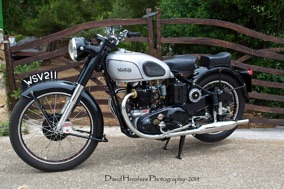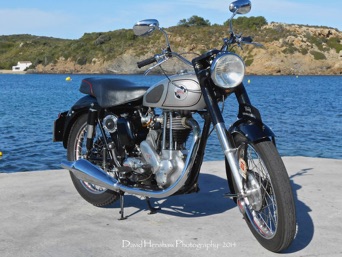Production: 1948-1955
Engine: type overhead valve single cylinder four-stroke
Capacity: 490cc
Bore x stroke: 79 x 100mm
Compression ratio: 6.8:1 (factory spec)
Ignition: magneto (Lucas Magdyno)
Electrics: 6 volt
Lubrication: dry sump lubrication with 4 pint oil tank
Transmission: chain, four speed gearbox
Final drive: chain
Suspension: Norton Roadholder telescopic fork with hydraulic damping front, swinging arm with two shock absorbers with hydraulic damping rear
Tyres: front 3.25 x 19 front and rear
Brakes: both sls drum
Weight: 369lb dry, 402lbs fully equipped for road with one gallon fuel
Wheelbase: 56.5in
Seat height: 31in
Fuel capacity: 3.5 gals
Power output: 29bhp @ 5300rpm
Top speed: 79mph (Motor Cycle road test 1953)
Fuel consumption: 60 - 75mpg Price New; £216.00
From early sporting leanings in the roaring 20s, Norton’s immortal 490cc pushrod engine developed into a delightful lusty slogger, fondly remembered by many. The ‘Easy’ 2 was a mainstay of the Norton range for over three decades, and it’s not difficult to see why it had such a devoted following...
The era has changed but power remains the same …
The ES2 made its debut at the 1927 Olympia Show and was generally produced to a more up to date specification than the Model 18. It featured the overhead valve engine as fitted to the Model 18, but with the magneto re-sited behind the cylinder, the drive coming off the primary chain.
The frame was of a new full cradle design which was also used on the brand new overhead camshaft CS1 machine. The petrol tank was of the saddle type then coming into vogue; by 1929, all the old flat tanks had been eliminated on Nortons. For 1931, there was a redesign of the right side crankcase to enable the magneto drive to be taken off the inlet camshaft. This was standardised on all other OHV and SV machines at the same time. A second drive side main bearing was added in 1934 along with valve guide oil pipes. The ES2 had its valve gear enclosed in 1938. There was an option of plunger rear suspension in 1939 as well as the International petrol tank.
During the year, with war clouds looming, all Norton production was turned over to side valve machines for the military. Production was resumed after the war with the plunger frame and telescopic forks now standard; then the engine internals received a lot of attention in 1948, with a number of modifications being incorporated. The laid down gearbox was fitted from 1950 and in 1951 a larger 3.5 gallon petrol tank was put onto the ES2 as well as other machines in the range. In 1952, the frame became a swinging arm type with Girling rear dampers; the 8" front brake was introduced in 1954; many changes occurred in 1957, most notably a new cylinder head with integral pushrod tunnels, and then in 1959 a change to alternator and coil ignition. In the same year the frame was replaced by the Wideline Featherbed, followed by the Slimline in 1961 until production ceased in 1963.
The letters 'ES' are thought to represent 'enclosed springs'.
This was my first experience in owning a Norton, the bike I longed to have when I was teenager but like many of those times it was an impossible financial dream .... 40 years on and here was my first true Norton.
I bought it in February 2013, unseen on Ebay, saying to the seller “wrap it up well!” - little surprised when it was unloaded to see the amount of packaging surrounding the entire bike. It turned out to be a bike that was in good overall condition but looked after poorly - a complete checked throughout revealed many things about “to fall off” but within a few weeks it was up and running well.
The bike has since been tested and registered in Spain and is ridden regularly on the dry roads throughout the stunning scenery of the island of Menorca which enjoys an exceptional warm and sunny climate throughout the year....
Please contact me with any questions you may have - david@digitaldiving.co.uk



